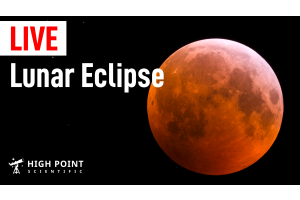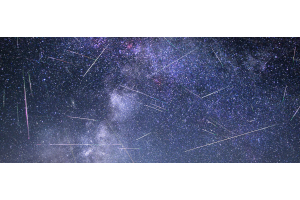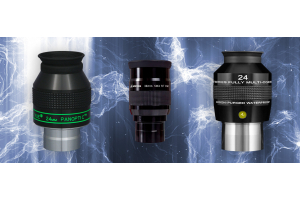
There are few natural events that can rival an eclipse, and whether you’re into astronomy or not, an eclipse is, without a doubt, one of the most awe-inspiring sights anyone can witness. Fortunately, while a total solar eclipse is only visible from a small number of locations around the world, a lunar eclipse can be seen from anywhere the Moon is visible.
Why is this? What’s the difference between a solar and lunar eclipse? Why do eclipses happen? And what happens during a total lunar eclipse?
Solar vs Lunar Eclipses - What’s the Difference?
A solar eclipse can only occur at the new Moon, when the Moon is between the Earth and the Sun and all three are aligned. As the Moon continues to move along its orbit, it casts a shadow onto the surface of the Earth, and anyone standing in this shadow will see a total solar eclipse. Observers need to be within the shadow in order for the Sun and Moon to appear aligned and for the total eclipse to occur.
Although the Moon is 400 times smaller than the Sun, it is also 400 times closer, and so the two appear the same size in the sky. As a result, observers on Earth see the Moon completely obscuring the Sun.
A lunar eclipse is almost the opposite of a solar eclipse. For starters, it can only occur at full Moon when the Moon is on the opposite side of the Earth from the Sun. Therefore, during a lunar eclipse, the Earth is directly between the Sun and the Moon.

The Earth, like the Moon during a solar eclipse, casts a shadow, and when the Moon passes through this shadow, we see a lunar eclipse. However, unlike a total solar eclipse, the darkened Moon is visible to anyone on the night side of the Earth, as long as the Moon is visible from that location.
If you’re wondering why solar and lunar eclipses don’t happen every month, it’s because the Moon’s orbit is inclined at an angle of 5.15 degrees. So most of the time, at new Moon, the Moon’s shadow will miss the Earth, while at full Moon, the Moon will pass either above or below the Earth’s shadow, and there is no eclipse.
Eclipses also frequently come in pairs, so when one eclipse occurs, another will follow just a few weeks later. For example, there was a new Moon and a partial solar eclipse on April 30th, 2022, then a full Moon and a total lunar eclipse on May 16th.
What are the Different Areas of the Earth’s Shadow?
There are three types of lunar eclipse, but before we review each one, we need to learn a little more about the Earth’s shadow. After all, it’s the Earth’s shadow that determines which type of eclipse will occur.
If you could clearly see the Earth’s shadow, it would look a little like a target. The “bullseye” at the center is the darkest part of the shadow and is known as the umbra. Surrounding this is the lighter part of the shadow, called the penumbra.
Now you know this, the three types of lunar eclipse are as follows: Penumbral, Partial, Total.
Penumbral or Partial - What’s the Difference?
As its name implies, a penumbral lunar eclipse occurs when the Moon only passes through the penumbra - the outer portion of the Earth’s shadow. As this is the lightest portion of the shadow, the Moon is only slightly dimmed. In fact, the chances are you might not notice anything different at all!
A partial lunar eclipse occurs when the Moon partially enters the umbra, the central and darkest portion of the Earth’s shadow. In this instance, you’ll see a portion of the Moon turn a coppery orange color, while the rest of its surface will appear its regular pearly white. Every partial eclipse is a little different, depending upon how much of the Moon is eclipsed. Sometimes you’ll get an eclipse that’s almost total - and might even look total to the naked eye - while other times the Moon will barely graze the umbra and you’ll hardly notice anything at all.
However, the vast majority of the time, the Moon will be obviously partially eclipsed, and how much of the surface will be in shadow is specified as a percentage. For example, the partial lunar eclipse of September 18th, 2024 was almost non-existent, with just 3.5% of the Moon in eclipse.
Compare that to the partial lunar eclipse of November 19th, 2021. In stark contrast, this eclipse was almost total, with 97% of the Moon in eclipse.

Image Credit: www.MrEclipse.com
Anatomy of a Total Lunar Eclipse
Lastly, a total lunar eclipse occurs when the entirety of the Moon’s surface is in shadow. The Moon passes completely through the umbra - the central portion of the Earth’s shadow - and we see the whole of the Moon turn a coppery color as a result.
The entire eclipse, from start to finish, typically takes between four and six hours, with six distinct stages:
- Penumbral Phase Begins
- Partial Phase Begins
- Totality Begins
- Totality Ends
- Partial Phase Ends
- Penumbral Phase Ends
The penumbral and partial phases each last about an hour, with totality itself potentially lasting less than a minute to nearly two hours. The length of totality (and to some extent, the intensity) depends upon the Moon’s path through the umbra. If the Moon skims through the outer portion of the umbra, then totality may only last a few minutes and the Moon might appear a light, coppery color. An example of this occurred on April 4th, 2015, when totality lasted less than five minutes.
However, if the Moon passes directly through the center of the umbra, then totality could last a maximum of an hour and 47 minutes, and the Moon may appear a darker orange. One eclipse that came close to this occurred on July 27th, 2018, when totality lasted almost an hour and 43 minutes.
For example, during the total lunar eclipse that starts on the evening of March 13th, 2025, the Moon will pass through the northwestern quadrant of the umbra, but miss the very center.
Here are the details, courtesy of TimeAndDate.com
| Phase | Date & Time (Eastern) | Duration |
|---|---|---|
| Penumbral Eclipse Begins | March 13th, 11:57 PM | 1 hour, 12 minutes |
| Partial Eclipse Begins | March 14th, 1:09 AM | 1 hour, 17 minutes |
| Total Eclipse Begins | March 14th, 2:26 AM | 1 hour, 5 minutes |
| Total Eclipse Ends | March 14th, 3:31 AM | |
| Partial Eclipse Ends | March 14th, 4:47 AM | 1 hour, 16 minutes |
| Penumbral Eclipse Ends | March 14th, 6:00 AM | 1 hour, 13 minutes |
What Happens During the Phases of a Lunar Eclipse?
When the penumbral phase begins, you might notice the Moon dimming slightly as it enters the Earth’s shadow, but it’s more likely you won’t notice a change at all. If you want to try and spot the difference, take a look at the Moon just before the eclipse begins, and then again when it’s about midway through the penumbral phase. (Don’t use an app or software to see which part of the Moon is already in the penumbra - see if you can detect the difference with just your eyes first!)
When the partial phase begins, you’ll see the leading edge of the Moon dim and start to darken. As the Moon slips into the umbra, more of its surface will be eclipsed and turn orange, providing a stark contrast to the portion of the disc that remains in the penumbra.
During totality, you’ll notice that some parts of the Moon are darker than others, depending on which edge is closest to the center of the umbra and which is nearer the penumbra. The darkness and color of the eclipse can also vary, depending upon the Earth itself.
The reason the Moon appears orange is because the Earth’s atmosphere scatters the shorter light wavelengths (blue light), leaving the longer wavelengths (orange and red light) behind. Dust and pollutants in our atmosphere also play a role, causing the Moon to appear darker. For example, volcanic eruptions can have a significant effect on eclipses.
Some eclipses are so dark that the Moon disappears completely. After a series of volcanic eruptions early in the 12th century, the Moon was said to be unusually dark - to the point of invisibility - particularly during the total lunar eclipse of May 5th, 1110 CE (see www.science.org for more information).

On the flip side, lunar eclipses can be so bright that it would seem as though the eclipse never happened at all. The total lunar eclipse of March 19th, 1848 started normally, but observers in England were surprised to see the Moon prematurely return to its normal brightness, twenty minutes before totality came to an end. According to one observer in Devon, “[..] the whole disk of the Moon being as perfect with light as if there had been no eclipse whatsoever” [sic].
The fact of the matter is that every eclipse is a unique and unmissable experience. It could be partial or total, bright or dark, and there could be bright stars and planets nearby. Regardless of the circumstances, a lunar eclipse is always worth venturing outside for!

Learn More
Interested in learning more about what's going on in the sky? Not sure where to begin? Check out our Astronomy Hub to learn more!
This Article was Originally Published on 10/05/2022








